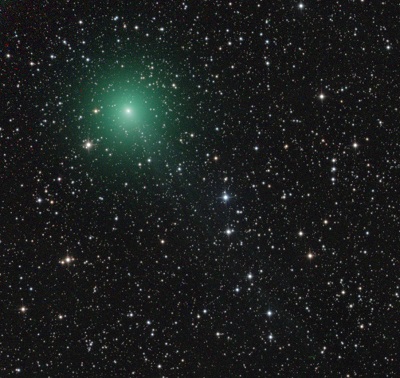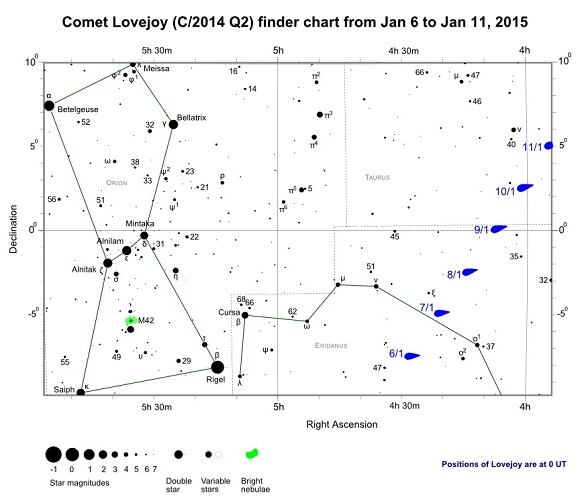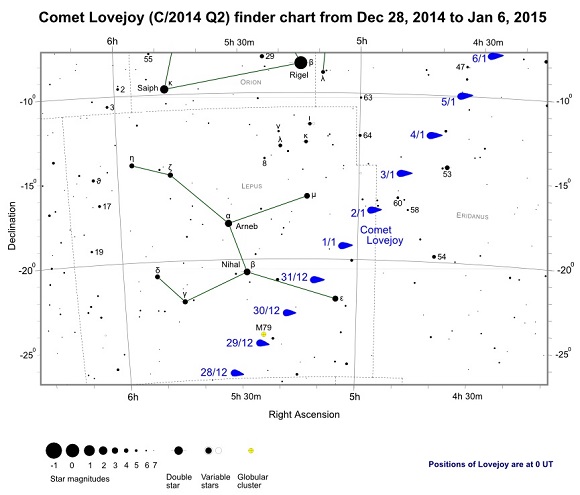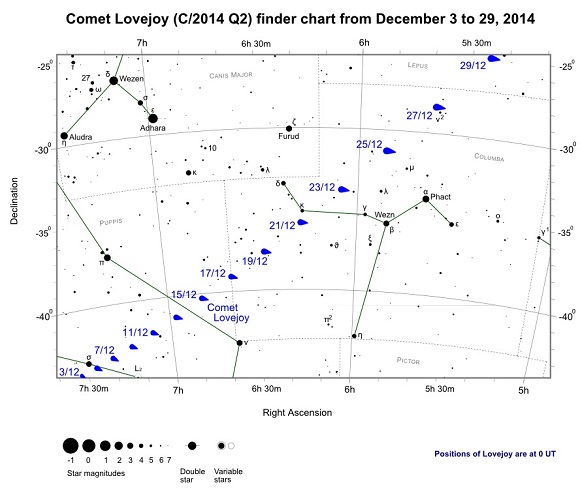As we head into the New Year, comet Lovejoy (C/2014 Q2) remains superbly placed for observation as it continues to brighten into January. The comet that was discovered by Australian amateur astronomer Terry Lovejoy has so far exceeded expectations and has been well seen from southern and tropical latitudes. For most of December, although Lovejoy was just beyond naked eye visibility it was an easy binocular and small telescope target, moving northwesterly through the southern constellations of Puppis, Columba and Lepus. By Christmas Day, Lovejoy had brightened to magnitude +5.4 and therefore within naked eye visibility. It's expected to peak at about magnitude +4.5 during the middle of January.
Northern Hemisphere based observers haven't had much of a look at Lovejoy but that's going to change. During the last days of December it can be spotted low down above the southern horizon with visibility continually improving as it climbs higher each subsequent evening. From southern latitudes, Lovejoy remains observable in excellent condition until late January.

Location and star chart
Comet Lovejoy started December in Puppis moving on a northwesterly trajectory. It then passed into Columba on December 17th where it remains until December 27th before crossing the border into Lepus. It passes close by globular cluster M79 on December 29th. On January 2nd, the comet moves into the large constellation of Eridanus remaining there for a week before crossing into Taurus on January 9th. It's expected to be close to peak brightness at this time and hopefully a nice naked eye sight with a long tail. As it continues to head north, Lovejoy moves into Aries on January 16th, Triangulum on January 24th and the into Andromeda on the last day of the month. Although still bright enough to be seen with the naked eye, Lovejoy is predicted to have faded to magnitude +5.3 by the beginning of February.
Many comets are often seen at their best either above the western horizon just after sunset or above the eastern horizon just before sunrise. Lovejoy is different in that it's positioned almost on the opposite side of sky to the Sun and therefore visible for much of the night. Adding to the splendour; from about January 5th to 13th the comet passes about 15 degrees west of probably the most famous constellation of the sky, Orion "the Hunter".
Over the next few weeks it will be very interesting to follow Lovejoy. It's already brighter than originally predicted and could brighten even further still. As with all comets, they are extremely unpredictable objects where anything can happen - and often does - so keep watching!!
The finder charts below show the positions of comet Lovejoy from December 3, 2014 to January 11, 2015.

Comet Lovejoy (C/2014 Q2) Finder Chart from January 6th to January 11th, 2015 - pdf format

Comet Lovejoy (C/2014 Q2) Finder Chart from December 28th, 2014 to January 6th, 2015 - pdf format

Comet Lovejoy (C/2014 Q2) Finder Chart from December 3rd to December 29th, 2014 - pdf format
C/2014 Q2 (Lovejoy) Data (at epoch December 9, 2014)
| Name | C/2014 Q2 (Lovejoy) |
|---|---|
| Type | Comet |
| Discoverer | Terry Lovejoy |
| Discovery date | August 17, 2014 |
| Perihelion (AU) | 1.29077 |
| Eccentricity | 0.99809 |
| Orbital period (years) | ~8000 |
| Inclination (degrees) | 80.3021 |
| Longitude of ascending node (degrees) | 94.9937 |
| Perihelion | January 30th, 2015 |
Comet (C2014/Q2) Lovejoy Data Table
| Date | Right Ascension | Declination | Mag. | Distance from Earth (AU) | Constellation |
|---|---|---|---|---|---|
| December 25, 2014 | 05h 52m 34s | -31d 17m 36s | +5.4 | 0.580 | Columba |
| December 26, 2014 | 05h 45m 58s | -29d 54m 00s | +5.3 | 0.565 | Columba |
| December 27, 2014 | 05h 39m 14s | -28d 23m 50s | +5.2 | 0.551 | Columba |
| December 28, 2014 | 05h 32m 24s | -26d 46m 54s | +5.1 | 0.538 | Lepus |
| December 29, 2014 | 05h 25m 28s | -25d 03m 07s | +5.1 | 0.526 | Lepus |
| December 30, 2014 | 05h 18m 28s | -23d 12m 28s | +5.0 | 0.515 | Lepus |
| December 31, 2014 | 05h 11m 23s | -21d 15m 04s | +4.9 | 0.505 | Lepus |
| January 01, 2015 | 05h 04m 16s | -19d 11m 08s | +4.8 | 0.496 | Lepus |
| January 02, 2015 | 04h 57m 09s | -17d 01m 04s | +4.8 | 0.488 | Lepus |
| January 03, 2015 | 04h 50m 01s | -14d 45m 22s | +4.7 | 0.482 | Eridanus |
| January 04, 2015 | 04h 42m 54s | -12d 24m 42s | +4.7 | 0.477 | Eridanus |
| January 05, 2015 | 04h 35m 49s | -09d 59m 53s | +4.6 | 0.473 | Eridanus |
| January 06, 2015 | 04h 28m 48s | -07d 31m 48s | +4.6 | 0.470 | Eridanus |
| January 07, 2015 | 04h 21m 52s | -05d 01m 29s | +4.6 | 0.469 | Eridanus |
| January 08, 2015 | 04h 15m 02s | -02d 29m 59s | +4.5 | 0.469 | Eridanus |
| January 09, 2015 | 04h 08m 18s | 00d 01m 38s | +4.5 | 0.471 | Eridanus |
| January 10, 2015 | 04h 01m 41s | 02d 32m 16s | +4.5 | 0.474 | Taurus |
| January 11, 2015 | 03h 55m 12s | 05d 00m 58s | +4.5 | 0.478 | Taurus |
| January 12, 2015 | 03h 48m 53s | 07d 26m 49s | +4.5 | 0.483 | Taurus |
| January 13, 2015 | 03h 42m 43s | 09d 49m 02s | +4.5 | 0.490 | Taurus |
| January 14, 2015 | 03h 36m 42s | 12d 06m 58s | +4.5 | 0.498 | Taurus |
| January 15, 2015 | 03h 30m 52s | 14d 20m 05s | +4.6 | 0.507 | Taurus |
| January 16, 2015 | 03h 25m 13s | 16d 28m 01s | +4.6 | 0.518 | Taurus |
| January 17, 2015 | 03h 19m 44s | 18d 30m 32s | +4.6 | 0.529 | Aries |
| January 18, 2015 | 03h 14m 26s | 20d 27m 28s | +4.7 | 0.541 | Aries |
| January 19, 2015 | 03h 09m 19s | 22d 18m 47s | +4.7 | 0.554 | Aries |
| January 20, 2015 | 03h 04m 23s | 24d 04m 34s | +4.7 | 0.567 | Aries |
| January 21, 2015 | 02h 59m 38s | 25d 44m 54s | +4.8 | 0.582 | Aries |
| January 22, 2015 | 02h 55m 03s | 27d 19m 58s | +4.8 | 0.597 | Aries |
| January 23, 2015 | 02h 50m 39s | 28d 49m 58s | +4.9 | 0.612 | Aries |
| January 24, 2015 | 02h 46m 25s | 30d 15m 08s | +4.9 | 0.629 | Aries |
| January 25, 2015 | 02h 42m 22s | 31d 35m 43s | +5.0 | 0.645 | Triangulum |
| January 26, 2015 | 02h 38m 28s | 32d 51m 58s | +5.0 | 0.662 | Triangulum |
| January 27, 2015 | 02h 34m 43s | 34d 04m 10s | +5.1 | 0.680 | Triangulum |
| January 28, 2015 | 02h 31m 08s | 35d 12m 32s | +5.1 | 0.697 | Triangulum |
| January 29, 2015 | 02h 27m 42s | 36d 17m 21s | +5.2 | 0.716 | Triangulum |
| January 30, 2015 | 02h 24m 25s | 37d 18m 50s | +5.2 | 0.734 | Triangulum |
| January 31, 2015 | 02h 21m 15s | 38d 17m 13s | +5.3 | 0.752 | Andromeda |
| February 01, 2015 | 02h 18m 14s | 39d 12m 43s | +5.3 | 0.771 | Andromeda |
| February 02, 2015 | 02h 15m 21s | 40d 05m 32s | +5.4 | 0.790 | Andromeda |
| February 03, 2015 | 02h 12m 35s | 40d 55m 53s | +5.5 | 0.809 | Andromeda |
| February 04, 2015 | 02h 09m 56s | 41d 43m 55s | +5.5 | 0.828 | Andromeda |
| February 05, 2015 | 02h 07m 24s | 42d 29m 48s | +5.6 | 0.848 | Andromeda |
| February 06, 2015 | 02h 04m 59s | 43d 13m 42s | +5.6 | 0.867 | Andromeda |
| February 07, 2015 | 02h 02m 40s | 43d 55m 46s | +5.7 | 0.887 | Andromeda |
| February 08, 2015 | 02h 00m 28s | 44d 36m 08s | +5.7 | 0.906 | Andromeda |
| February 09, 2015 | 01h 58m 21s | 45d 14m 54s | +5.8 | 0.926 | Andromeda |
| February 10, 2015 | 01h 56m 20s | 45d 52m 13s | +5.9 | 0.945 | Andromeda |
| February 11, 2015 | 01h 54m 24s | 46d 28m 10s | +5.9 | 0.965 | Andromeda |
| February 12, 2015 | 01h 52m 34s | 47d 02m 51s | +6.0 | 0.984 | Andromeda |
| February 13, 2015 | 01h 50m 49s | 47d 36m 22s | +6.0 | 1.004 | Andromeda |
| February 14, 2015 | 01h 49m 08s | 48d 08m 49s | +6.1 | 1.023 | Perseus |
| February 15, 2015 | 01h 47m 32s | 48d 40m 15s | +6.1 | 1.043 | Andromeda |
| February 16, 2015 | 01h 46m 01s | 49d 10m 46s | +6.2 | 1.062 | Andromeda |
| February 17, 2015 | 01h 44m 34s | 49d 40m 25s | +6.3 | 1.081 | Andromeda |
| February 18, 2015 | 01h 43m 11s | 50d 09m 16s | +6.3 | 1.100 | Andromeda |
| February 19, 2015 | 01h 41m 52s | 50d 37m 23s | +6.4 | 1.119 | Andromeda |
| February 20, 2015 | 01h 40m 37s | 51d 04m 49s | +6.4 | 1.139 | Perseus |
| February 21, 2015 | 01h 39m 26s | 51d 31m 37s | +6.5 | 1.157 | Perseus |
| February 22, 2015 | 01h 38m 18s | 51d 57m 50s | +6.5 | 1.176 | Perseus |
| February 23, 2015 | 01h 37m 14s | 52d 23m 30s | +6.6 | 1.195 | Perseus |
| February 24, 2015 | 01h 36m 13s | 52d 48m 41s | +6.7 | 1.214 | Perseus |
| February 25, 2015 | 01h 35m 15s | 53d 13m 24s | +6.7 | 1.232 | Perseus |
| February 26, 2015 | 01h 34m 20s | 53d 37m 41s | +6.8 | 1.250 | Perseus |
| February 27, 2015 | 01h 33m 28s | 54d 01m 34s | +6.8 | 1.269 | Perseus |
| February 28, 2015 | 01h 32m 39s | 54d 25m 05s | +6.9 | 1.287 | Perseus |
See also
Comet Lovejoy (C/2014 Q2) heads north during March, remains a binocular and small telescope object
Comet Lovejoy (C/2014 Q2) remains visible with binoculars and small telescopes during February 2015
How to see Comet Lovejoy (C/2014 Q2) during January 2015
Comet Lovejoy (C/2014 Q2) now visible with binoculars from Southern latitudes